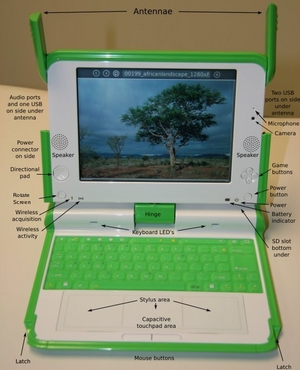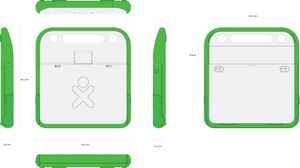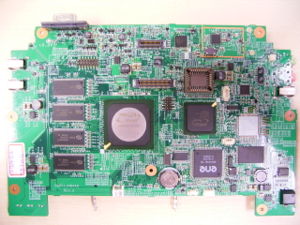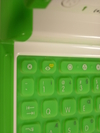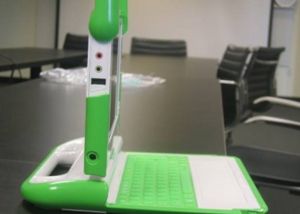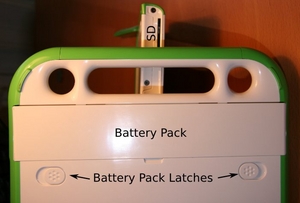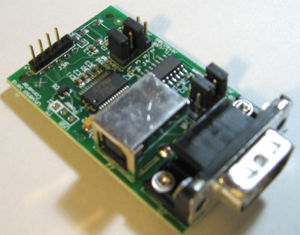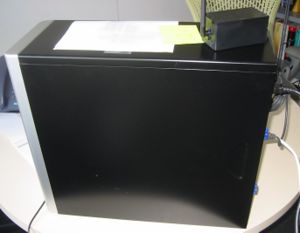Hardware specification/lang-ja
| 翻訳された Hardware specification | 原文 |
| deutsch | english | español | français | italian | 日本語 | 한글 | português | русский indonesia +/- | 変更 |
- This is an on-going translation
Contents
- 1 ラップトップ ハードウェア
- 1.1 仕様
- 1.2 Laptop Development Schedule
- 1.2.1 Mass Production Systems
- 1.2.2 Preproduction Test Systems (CTest-2, or C2)
- 1.2.3 Preproduction Test Systems (CTest-1, or C1)
- 1.2.4 Beta Test 4 Systems (BTest-4, or B4)
- 1.2.5 Beta Test 3 Systems (BTest-3, or B3)
- 1.2.6 Beta Test 2 Systems (BTest-2, or B2)
- 1.2.7 Beta Test 1 Systems (BTest-1)
- 1.2.8 Pre-BTest boards
- 1.2.9 Alpha Test Prototype Electronics
- 1.2.10 Software on the development systems
- 1.3 See also
- 2 School Server Hardware
ラップトップ ハードウェア
XOラップトップはOne Laptop Per Childの中心となるものです。3年に渡る開発の後に量産が始まりつつあり、数千のベータテスト(B2)装置が開発者によって使われ、参加国の学校でテストされています。技術の進歩に追従するためにラップトップの設計の最終的な小変更が行われました。
The XO laptop is the center of One Laptop Per Child. After three years of development, it is approaching mass production, with several thousand Beta test (B2) units deployed to developers and for testing in schools in participating countries. The laptop design has just undergone a final minor update to keep up with advancements in technology.
仕様
正式なラップトップの仕様はPDFでのみ提供されます。このページはできる限り正確にその情報を反映するようにします。
The definitive laptop specification is only available in PDF format. This page attempts to accurately reflect that information.
寸法
- おおよその寸法: 242mm × 228mm × 30mm (詳細な寸法は右の図面を見てください)
- おおよその重量:
- LiFePバッテリ付のXO: 1.45kg (~3.20lbs)
- NiMHバッテリ付のXO: 1.58kg (~3.48lbs)
- 構成: 回転軸付きコンバーチブル・ラップトップ、反転可能なディスプレイ、防塵および防滴筐体、ファンなし
- Approximate dimensions: 242mm × 228mm × 32mm (see drawing to the right for detailed dimensions)
- Approximate weight:
- XO laptop with LiFeP battery: 1.45KG (~3.20lbs);
- XO laptop with NiMH battery: 1.58KG (~3.48lbs);
- Configuration: Convertible laptop with pivoting, reversible display; dirt- and moisture-resistant system enclosure; no fan.
核となる電子部品
- CPU: x86互換プロセッサ、64KBのL1とIおよびDキャッシュ、最低128KBのL2キャッシュ
- CPUクロックスピード: 433 MHz
- ISA互換: MMXと3DNow!のx86拡張命令セットをサポート
- Athlon命令セット(MMXと3DNow!拡張を含む)に加えてGeode専用命令セット
- 周辺チップ: CPUに統合されたPCIとメモリインタフェース
- ノースブリッジ: Geode CPUに統合されたPCIとメモリインタフェース(情報)
- サウスブリッジ: AMD CS5536 (データシート)
- グラフィックコントローラ: CPUに統合、統合メモリアーキテクチャ
- 組込コントローラ: ENE KB3700またはENE KB3700B
- DRAMメモリ: 256 MB ダイナミックRAM、データレート: デュアルDDR333-166MHz
- BIOS: 1024KB SPIインタフェース フラッシュROM
- オペレーティングシステムをロードするためのOpen Firmware
- 大容量記憶装置: 1024 MB SLC NANDフラッシュ、高速フラッシュコントローラ
- デバイス: 回転メディアなし.
- CAFE ASIC (カメラとフラッシュイネーブラチップにより、高性能カメラ、NANDフラッシュ、SDインタフェースを提供)、Marvell 88ALP01: CAFE仕様
- CPU: x86-compatible processor with 64KB each L1 I and D cache; at least 128KB L2 cache;
- CPU clock speed: 433 Mhz;
- ISA compatibility: Support for both the MMX and 3DNow! x86 instruction-set extensions;
- Athlon instruction set (including MMX and 3DNow! Enhanced) with additional Geode-specific instructions
- Companion chips: PCI and memory interface integrated with CPU;
- North Bridge: PCI and Memory Interface integrated with Geode CPU (info)
- South Bridge: AMD CS5536 (datasheet)
- Graphics controller: Integrated with CPU; unified memory architecture;
- Embedded controller: ENE KB3700 or ENE KB3700B;
- DRAM memory: 256 MiB dynamic RAM; data rate: dual-DDR333-166Mhz;
- BIOS: 1024KiB SPI-interface flash ROM;
- Open Firmware used to load the operating system;
- Mass storage: 1024 MiB SLC NAND flash, high-speed flash controller;
- Drives: No rotating media.
- CAFE ASIC (camera- and flash-enabler chip provides high-performance camera, NAND FLASH and SD interfaces); Marvell 88ALP01: CAFE Specification
ディスプレイ
- 液晶ディスプレイ: 7.5” デュアルモードTFTディスプレイ
- 表示エリア: 152.4 mm × 114.3 mm
- 2つのモード: (1)グレイスケール(白黒)反射モード(屋外での使用時に太陽光で読み取れる) (2)カラーバックライトモード(屋内で使用)
- 反射モード: 高解像度(200 DPI)、1200(H) × 900(V) グレイスケールピクセル、消費電力 0.1–0.2W
- バックライトモード: 高解像度ディスプレイの組込みサブピクセルサンプリングにより、およそ800(H) × 600(V) カラーピクセル、消費電力 0.2–1.0W
- メモリ内蔵ディスプレイコントローラチップ(DCON)は、プロセッサがサスペンドしていても、表示を可能にします。また、DCONはディスプレイのためにデータを初期化します。
- この液晶ディスプレイは私たちの究極の低消費電力技術に基づきます。このXOは、CPUとマザーボードの大部分が、ユーザが気付かないほど定期的に高速で電源を断続していても使用できます。この方法により、大きく電力を節約することができます(たとえば、使用していないときに(たとえ数秒間でも)、電源管理機能がマザーボードを切っても、ディスプレイは表示されたままです)。
- 注記: Webブラウザの画像は、非常に荒く[800 × 600]、ブラウザのウィンドウを埋められるように現在拡大されています。
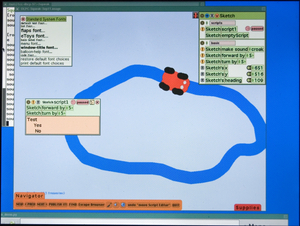
- Liquid-crystal display: 7.5” dual-mode TFT display;
- Viewing area: 152.4 mm × 114.3 mm;
- Two modes: (1) grayscale (B&W) reflective mode (for outdoor use—sunlight-readable); and (2) color backlight Mode (for indoor use);
- reflective mode: high-resolution (200 DPI), 1200(H) × 900(V) grayscale pixels, power consumption 0.1–0.2Watts;
- backlight mode: built in sub-pixel sampling of the high-resolution display results in approximately 800(H) × 600(V) color pixels, power consumption 0.2–1.0Watts;
- The display-controller chip (DCON) with memory that enables the display to remain live with the processor suspended. The DCON also formats data for the display.
- This Liquid-crystal display is the basis of our extremely low power architecture. The XO is usable while the CPU and much of the motherboard is regularly turned off (and on) so quickly that it's imperceptible to the user. Huge power savings are harvested in this way (e.g. by turning stuff on the motherboard off when it's not being used (if even for a few seconds), while keeping the display on).
- Note: web browser images are currently scaled up so that an image of very roughly [800 × 600] fills up the browser window.
統合された周辺機器
- キーボード: 80+ キー、1.0mm ストローク、密閉されたラバーメンブレン・キースイッチ部品
- ゲームパッド: 2組の4方向カーソルコントロールキー
- タッチパッド: 静電/抵抗膜式デュアルタッチパッド、手書き入力モードをサポート
- アルプス電気 静電/抵抗膜式デュアルタッチパッド
- オーディオ: AC’97互換オーディオサブシステム、内蔵ステレオスピーカーとアンプ、内蔵モノラルマイク、外部ヘッドホンとマイク端子
- カメラ: 内蔵カラービデオカメラ、30 FPSで解像度 640 x 480、マイクとカメラの記録状態を表示する独立した(ソフトウェアから制御できない)表示装置、カメラとデバイスドライバは、教育用アプリケーションのための光センサとして使用できるようにするためにAGC(自動利得制御)と自動カラーバランスの無効化をサポート
- 無線ネットワーク: 802.11b/g (2.4GHz)統合インタフェース、802.11s (メッシュ)ネットワークをサポート; ダイバシティ受信をサポートした2つの調整可能な回転式アンテナ、CPUの電源が切れていてもメッシュの運用は可能
- 状態インジケータ: 電源、電池、WiFi(2)、マイク使用中、カメラ使用中、蓋が開いていても閉じていても確認可能
外部コネクタ
- DC電源: 6mm (1.65mm センターピン)コネクタ; 11から18Vの入力で使用可能、–32から40Vの入力に耐える、電力の制限は15Wまで
- ヘッドホン出力: 標準 3.5mm 3ピン スイッチ付きステレオ音声ジャック
- マイク入力: 標準 3.5mm 2ピン スイッチ付きモノラルマイクジャック、2V DC バイアスを選択可能、センサ入力モードを選択可能(DCあるいはAC結合)
- USB: 3つのタイプA USB 2.0コネクタ、1Aまでの電源供給(合計)
- フラッシュ拡張: SDカードスロット
- DC power: 6mm (1.65mm center pin) connector; 11 to 18 V input usable, –32 to 40V input tolerated; power draw limited to 15 W;
- Headphone output: standard 3.5mm 3-pin switched stereo audio jack;
- Microphone input: standard 3.5mm 2-pin switched mono microphone jack; selectable 2V DC bias; selectable sensor-input mode (DC or AC coupled);
- USB: Three Type-A USB 2.0 connectors; Up to 1A power supplied (total);
- Flash Expansion: SD Card slot.
バッテリ
- パックタイプ: 2または4セル LiFePO4、あるいは5セル NiMH、およそ6V 直列接続(変更予定)
- 容量: 16.5 WH (NIMH), 22 WH (LiFeP);
- 完全密閉「ハード」ケース、取り外し可能
- パックに統合された電子部品:
- 識別;
- 充電と容量モニタチップ(Maxim DS2756 データシート);
- バッテリ保護のためのカットオフスイッチ付きの温度と過電流センサ
- 最大2,000回の充放電サイクル(新品時の50%容量)
- パワーマネジメント が重要となる
- Pack type: 2 or 4 cells LiFePO4; or 5 cells NiMH, approx. 6V series configuration (subject to change);
- Capacity: 16.5 Watt-hours (NIMH), 22 Watt-hours (LiFeP);
- Fully-enclosed “hard” case; user removable;
- Electronics integrated with the pack provide:
- Identification;
- Battery charge and capacity monitoring chip (Maxim DS2756 data sheet);
- Thermal and over-current sensors along with cutoff switch to protect battery;
- Minimum 2,000 charge/discharge cycles (to 50% capacity of new).
- Power Management will be critical
BIOS/ローダ
- Open Firmware (ハードウェアの初期化と高速リジュームを含む).
- Open Firmware (including hardware initialization and fast resume).
Environmental specifications
- Temperature: UL certification planned to 45C in Q32007, pending 50C certification in mid-2008;
- Humidity: UL certification planned to IP42 (perhaps higher) when closed, the unit should seal well enough that children walking to and from school need not fear rainstorms and dust;
- Maximum altitude: –15m to 3048m (14.7 to 10.1 PSIA) (operating), –15m to 12192m (14.7 to 4.4 PSIA) (non-operating);
- Shock 125g, 2ms, half-sine (operating) 200g, 2ms, half-sine (non-operating);
- Random vibration: 0.75g zero-to-peak, 10Hz to 500Hz, 0.25 oct/min sweep rate (operating); 1.5g zero-to-peak, 10Hz to 500Hz, 0.5 oct/min sweep rate (nonoperating);
- 2mm plastic walls (1.3mm is typical for most systems).
- Temperature: UL certification planned to 45C in Q32007, pending 50C certification in mid-2008;
- Humidity: UL certification planned to IP42 (perhaps higher) when closed, the unit should seal well enough that children walking to and from school need not fear rainstorms and dust;
- Maximum altitude: –15m to 3048m (14.7 to 10.1 PSIA) (operating), –15m to 12192m (14.7 to 4.4 PSIA) (non-operating);
- Shock 125g, 2ms, half-sine (operating) 200g, 2ms, half-sine (non-operating);
- Random vibration: 0.75g zero-to-peak, 10Hz to 500Hz, 0.25 oct/min sweep rate (operating); 1.5g zero-to-peak, 10Hz to 500Hz, 0.5 oct/min sweep rate (nonoperating);
- 2mm plastic walls (1.3mm is typical for most systems).
Regulatory requirements
- The usual US and EU EMI/EMC (electromagnetic-interference and electromagnetic-compatibility) requirements will be met;
- The laptop meets IEC 60950-1, EN 60950-1, and CSA/UL 60950-1 specifications. It also complies with UL 1310 and UL 498. In order to guarantee the safety of children using the laptop, it passes ASTM F 963;
- The external power adapter complies with IEC, EN, and CSA/UL 60950-1;
- The removable battery pack complies with IEC, EN, and CSA/UL 60950-1 and UL 2054;
- RoHS (Restriction of Hazardous Substances Directive – EU) compliant.
- The usual US and EU EMI/EMC (electromagnetic-interference and electromagnetic-compatibility) requirements will be met;
- The laptop meets IEC 60950-1, EN 60950-1, and CSA/UL 60950-1 specifications. It also complies with UL 1310 and UL 498. In order to guarantee the safety of children using the laptop, it passes ASTM F 963;
- The external power adapter complies with IEC, EN, and CSA/UL 60950-1;
- The removable battery pack complies with IEC, EN, and CSA/UL 60950-1 and UL 2054;
- RoHS (Restriction of Hazardous Substances Directive – EU) compliant.
Support Hardware
Serial Adapter (for developers)
Laptop Development Schedule
Mass Production Systems
Started November 2007.
Preproduction Test Systems (CTest-2, or C2)
Pre-build of 50 motherboards in October to test last minute changes.
Preproduction Test Systems (CTest-1, or C1)
This build is of 300 laptops produced as a test of the manufacturing process on the main production line, and should happen starting August 6th, 2007. Slip resistance rubber feet will be added as will more easily replaceable bunny ears (just two screws per ear after bezel removal). The hinge stop that appeared in B3/B4 will be eliminated or reduced (this is used to the stop the display at perpendicular before it tilts back further). Bean texture will be applied to the exterior white parts and "satin" texture to the the rest of the laptop plastic parts. A C1 laptop will be nearly identical to the production unit ...
Preproduction Test Systems have a label under the battery that says C-TEST-SAMPLE.
Beta Test 4 Systems (BTest-4, or B4)
This build which ran from June 20-25, 2007, was the final chance to fix hardware and mechanical problems that were detected in the Beta Test 3 build of the XO. 2000 units were built.
Texture was added to the upper handle bar, the hinge tilt was increased by 7 degrees, the hinge "squeak" was eliminated, the rabbit ears click in place when put in the "down" position", the slight camera vignetting seen in B3 was eliminated, and minor modifications were made to the motherboard.
Beta Test 4 Systems have a label under the battery that says B4-TEST-SAMPLE.
Beta Test 4 Systems work with current software releases. They may experience hardware problems with extensive suspend/resume or low battery.
Beta Test 3 Systems (BTest-3, or B3)
This build—May 2007—is the first to use an updated design for the laptop. It was the first build providing the processor and memory capabilities of the production version. Noticeable improvements over BTest-2 include:
- A faster, lower power processor: the Geode LX-700
- 64 KB I/64 KB D of L1 Cache, 128 KB of L2 Cache (vs. 32 KB of L1 cache)
- Faster processor and memory clock (433/333 vs. 366/266)
- 1.5 W typ. vs. 3 W typ.
- Much better graphics processor, including support for rotated blits and depth conversion
- More memory: 256 MB of SDRAM (vs. 128 MB)
- extra screws
- insert molded rubber ears for better robustness
- a smaller battery cavity to improve robustness, make the bumper lines cleared
- 10-20V input voltage tolerance.
- new bumper tooling to allow the bumpers to be made of polycarbonate (as opposed to PC/ABS) with 3mm thickness and ribbing to 1.8mm (was 2mm and 1.2mm respectively)
- colored XO on the back cover (400 different color combinations so kids can distinguish their laptops from each other
- A keyboard that is much better to type on
- Finally a touchpad that is much easier to use and much more responsive
- a steel plate inside the entire keyboard base to reduce the feeling of flimsiness
- a flipped USB connector so each side has the same way up for a USB key or device
- A new hinge design allows greater tilt of the screen
- An improved case design (addressing strength)
A very small number of BTest-3 units (around a hundred) were built, all were used for hardware and low level software development.
Beta Test 3 Systems have a label under the battery that says B3-TEST-SAMPLE.
Beta Test 3 Systems work with current software releases. They may experience hardware problems with extensive suspend/resume or low battery.
Beta Test 2 Systems (BTest-2, or B2)
Approximately 2500 systems were built by Quanta and distributed. These are fully functional machines with CaFE ASICs, and reflect some, but not all of the learning and improvements from testing of BTest-1. Much more information about the BTest-2 systems can be found in the BTest-2 Release Notes. Some of the details of the hardware design are to support the OLPC Human Interface Guidelines.
BTest-2 systems are almost identical visually with BTest-1. BTest-3 will have more substantial physical differences. An easy way to tell the difference between BTest-1 and BTest-2 is that BTest-1 keyboards have white lettering, and BTest-2 has black lettering.
There are two flavors of B2. Beta Test 2-1 (B2-1) systems, which only have 128 MB of memory, have a label under the battery that says B2-TEST-SAMPLE and a label that says B2-#, where # is one to 16. Beta Test 2-2 (B2-2) systems, which have 256MB of memory, have a label under the battery that says B2-7-ext.
Beta Test 2-1 laptops do not perform well with current software releases.
Beta Test 1 Systems (BTest-1)
Approximately 875 systems were built by Quanta in November 2006 and distributed. The BTest-1 systems were fully functional machines (compared to a BTest-2 system), but built before the custom integrated circuits were available. An Altera FPGA is used in place of the CaFE ASIC which is present in later builds, for NAND flash, camera, and SD interfaces. This FPGA has lower performance and consumes much more power than the CaFE ASIC does.Much more information about the BTest-1 systems can be found in the BTest-1 Release Notes. (Beta Test 1 Systems have a label under the battery that says B1-TEST-SAMPLE.)
BTest-1 and pre-BTest systems are no longer supported by our current software releases.
Pre-BTest boards
A small number of pre-BTest boards were built in preparation for building complete BTest systems. Developer information about B-test boards are here.
Alpha Test Prototype Electronics
Power up of the first OLPC electronics prototype boards occurred April 15, 2006. Power and ground testing continued over the weekend, and formal debug and BIOS bring up started Monday, April 17, 2006 at Quanta Computer's labs in Taipei, Taiwan. By Wednesday, April 19, Linux was booting on the first generation prototypes.
Photographs:
- Component side OLPC circuit board
- Back side of the OLPC circuit board
- Picture of Linux running with circuit board in the lab
- Picture of the screen of Linux running on the OLPC circuit board; fittingly, it shows a Chinese desktop
ATest systems are no longer supported by our current software releases.
Software on the development systems
C2:
- Everything works with the exception of a few items in Trac and any yet to be discovered bugs;
C1/B4/B3:
- There may be occasional crashes (possibly made worse by suspend/resume) when the battery is running low. Above 25% of capacity, or plugged into a power adapter, you should be OK ([1]);
- There may be times when the WLAN (USB) hangs (possibly made worse by suspend/resume) ([2], [3]);
- Power cycling the DCON is liable to crash the laptop. This power cycling will occasionally happen in response to a DCON bug triggered by suspend/resume ([4]);
- Rare crashes may be caused by other sources during suspend/resume (Camera, SD card, clock settling time), some units (especially B3s) may be more sensitive than others ([5]);
B2:
- All of the problems listed for C1/B4/B3 are present;
- The keyboard/touchpad may not be used to wakeup from a suspend/resume ([6]);
- The DCON will glitch coming out of suspend/resume ([7]);
- The camera will not work properly;
A:
- A Test is no longer supported. Do not load D- or C-series firmware on A Test machines.
See also
Environmental Impact
Hardware
Support
The definitive laptop specification (only available in PDF format).
Formerly part of this page:
Hardware uniqueness
Hardware design
Hardware modification
School Server Hardware
While the laptop is rightfully at the center of OLPC, a valuable peripheral is the school server. OLPC will be building and distributing school servers along with the laptops, to extend the storage and computation provided by each laptop, as well as providing a local library and a mesh portal to the Internet.
Unlike the laptop, the school server is more of a collection of services than a hardware platform. In a manner identical to the laptop, OLPC will collaborate with manufacturing partners to provide a cost-efficient hardware platform for running the recommended software. Unlike the laptop, the manufacturing collaboration will not be exclusive. Individual countries will be free (even encouraged) to design and manufacture their own school servers running derivatives of the OLPC school server software.
XS
This will be the school server designed by OLPC. It is mostly designed, but currently on hold as we reconsider manufacturers, and should reach early production volumes in spring 2008. See the specification.
XSX
This is a prototype school server, built for early school trials in country. It will be integrated from off-the-shelf components, and will be overpowered compared to a production school server in order to simplify early demands for system software. See the specification and the implementation.
